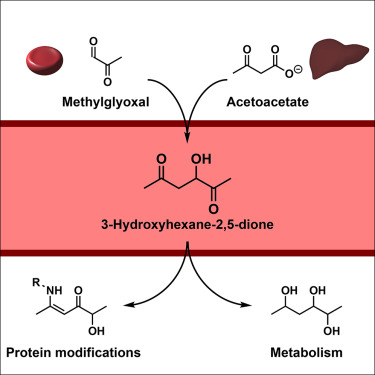当前位置:
X-MOL 学术
›
Cell Chem. Bio.
›
论文详情
Our official English website, www.x-mol.net, welcomes your feedback! (Note: you will need to create a separate account there.)
Ketone Body Acetoacetate Buffers Methylglyoxal via a Non-enzymatic Conversion during Diabetic and Dietary Ketosis
Cell Chemical Biology ( IF 8.6 ) Pub Date : 2017-08-17 , DOI: 10.1016/j.chembiol.2017.07.012 Trine Salomón , Christian Sibbersen , Jakob Hansen , Dieter Britz , Mads Vandsted Svart , Thomas Schmidt Voss , Niels Møller , Niels Gregersen , Karl Anker Jørgensen , Johan Palmfeldt , Thomas Bjørnskov Poulsen , Mogens Johannsen
Cell Chemical Biology ( IF 8.6 ) Pub Date : 2017-08-17 , DOI: 10.1016/j.chembiol.2017.07.012 Trine Salomón , Christian Sibbersen , Jakob Hansen , Dieter Britz , Mads Vandsted Svart , Thomas Schmidt Voss , Niels Møller , Niels Gregersen , Karl Anker Jørgensen , Johan Palmfeldt , Thomas Bjørnskov Poulsen , Mogens Johannsen

|
The α-oxoaldehyde methylglyoxal is a ubiquitous and highly reactive metabolite known to be involved in aging- and diabetes-related diseases. If not detoxified by the endogenous glyoxalase system, it exerts its detrimental effects primarily by reacting with biopolymers such as DNA and proteins. We now demonstrate that during ketosis, another metabolic route is operative via direct non-enzymatic aldol reaction between methylglyoxal and the ketone body acetoacetate, leading to 3-hydroxyhexane-2,5-dione. This novel metabolite is present at a concentration of 10%–20% of the methylglyoxal level in the blood of insulin-starved patients. By employing a metabolite-alkyne-tagging strategy it is clarified that 3-hydroxyhexane-2,5-dione is further metabolized to non-glycating species in human blood. The discovery represents a new direction within non-enzymatic metabolism and within the use of alkyne-tagging for metabolism studies and it revitalizes acetoacetate as a competent endogenous carbon nucleophile.
中文翻译:

糖尿病和饮食性酮症病患者中酮体乙酰乙酸盐通过非酶转化作用缓冲甲基乙二醛
α-氧醛甲基乙二醛是一种普遍存在的高反应性代谢产物,已知与衰老和糖尿病相关的疾病有关。如果不被内源性乙二醛酶系统解毒,它主要通过与生物聚合物(例如DNA和蛋白质)反应而发挥其有害作用。我们现在证明,在酮症中,另一种代谢途径是通过甲基乙二醛与酮体乙酰乙酸酯之间直接的非酶促醛醇缩合反应而起作用的,从而导致3-羟基己烷-2,5-二酮。在胰岛素匮乏的患者的血液中,这种新的代谢产物的浓度为甲基乙二醛水平的10%–20%。通过采用代谢物-炔烃标记策略,可以明确3-羟基己烷-2,5-二酮在人血中进一步代谢为非糖基化物质。
更新日期:2017-08-17
中文翻译:

糖尿病和饮食性酮症病患者中酮体乙酰乙酸盐通过非酶转化作用缓冲甲基乙二醛
α-氧醛甲基乙二醛是一种普遍存在的高反应性代谢产物,已知与衰老和糖尿病相关的疾病有关。如果不被内源性乙二醛酶系统解毒,它主要通过与生物聚合物(例如DNA和蛋白质)反应而发挥其有害作用。我们现在证明,在酮症中,另一种代谢途径是通过甲基乙二醛与酮体乙酰乙酸酯之间直接的非酶促醛醇缩合反应而起作用的,从而导致3-羟基己烷-2,5-二酮。在胰岛素匮乏的患者的血液中,这种新的代谢产物的浓度为甲基乙二醛水平的10%–20%。通过采用代谢物-炔烃标记策略,可以明确3-羟基己烷-2,5-二酮在人血中进一步代谢为非糖基化物质。


























 京公网安备 11010802027423号
京公网安备 11010802027423号